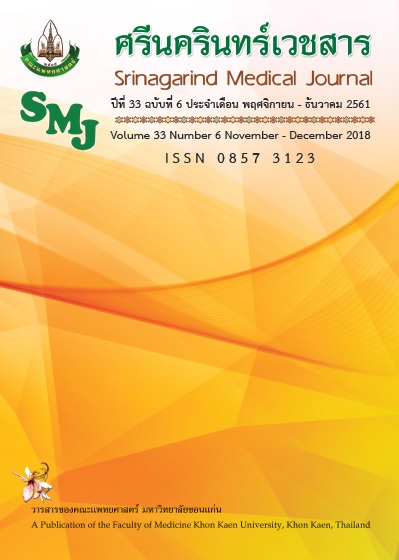การพัฒนาเว็บแอปพลิเคชันสำหรับโปรแกรมการบริหารข้อไหล่ในผู้ป่วยภายหลังทำการรักษาด้วยการผ่าตัดฝังเครื่องจัดการจังหวะการเต้นของหัวใจ
คำสำคัญ:
โปรแกรมการบริหารข้อไหล่บทคัดย่อ
หลักการและวัตถุประสงค์: โปรแกรมบริหารข้อไหล่ในผู้ป่วยภายหลังการผ่าตัดฝังเครื่องจัดการจังหวะการเต้นของหัวใจประกอบด้วย 4 ระยะ ซึ่งสามารถลดความเสี่ยงในการเกิดข้อไหล่ติดแข็ง แต่อย่างไรก็ตามอาจเกิดความเสี่ยงในการให้คำแนะนำโปรแกรมบริหารข้อไหล่ฯ ที่ผิดพลาดจากบุคลากรทางการแพทย์ได้ ดังนั้นการศึกษาครั้งนี้จึงมีวัตถุประสงค์เพื่อพัฒนาเว็บแอปพลิเคชันสำหรับโปรแกรมการบริหารข้อไหล่ฯ บนเครือข่ายอินเตอร์เน็ต
วิธีการศึกษา: การศึกษาเชิงพัฒนาซึ่งประกอบด้วยขั้นตอนการพัฒนาและการประเมินผลการใช้งานเว็บแอปพลิเคชันโปรแกรมการบริหารข้อไหล่ฯ บนเครือข่ายอินเตอร์เน็ต โดยแพทย์และนักกายภาพบำบัดรวมจำนวน 10 ราย
ผลการศึกษา: เว็บแอปพลิเคชันสำหรับโปรแกรมการบริหารข้อไหล่ฯ สามารถแสดงผลบนเว็บเบราว์เซอร์ได้ในหลายอุปกรณ์ และสามารถให้ข้อมูลโปรแกรมบริหารข้อไหล่ฯ ได้อย่างถูกต้อง ผู้ใช้งานมีความพึงพอใจในด้านประสิทธิภาพ, การออกแบบ และในภาพรวมต่อการใช้งานเว็บแอปพลิเคชันในระดับมากที่สุด โดยมีค่าคะแนนเฉลี่ยเท่ากับ 4.80 จากคะแนนเต็ม 5.00 และไม่มีปัญหาทางเทคนิคเมื่อใช้งานรวมถึงตอบสนองความต้องการของผู้ใช้งานได้เป็นอย่างดี
สรุป: เว็บแอปพลิเคชันสำหรับโปรแกรมการบริหารข้อไหล่ฯ บนเครือข่ายอินเตอร์เน็ต สามารถทำงานได้มีประสิทธิภาพและให้ข้อมูลที่ถูกต้องตามโปรแกรมบริหารข้อไหล่ฯ สามารถนำมาใช้งานได้จริงและเพิ่มประสิทธิภาพแก่บุคลากรทางการแพทย์ในการให้บริการอีกด้วย
เอกสารอ้างอิง
2. Stevenson I, Voskoboinik A. Cardiac rhythm management devices Aust J Gen Pract 2018; 47: 264-71.
3. Fuertes B, Toquero J, Arroyo-Espliguero R, Lozano IF. Pacemaker lead displacement: mechanisms and management. Indian Pacing Electrophysiol J 2003; 3: 231-8.
4. Korte T, Jung W, Schlippert U, Wolpert C, Esmailzadeh B, Fimmers R, et al. Prospective evaluation of shoulder-related problems in patients with pectoral cardioverter-defibrillator implantation. Am Heart J 1998; 135: 577-83.
5. เบญจา แซ่ลิ้ม, ภัทรพงษ์ มกรเวส. ผลของการติดตามการให้โปรแกรมการบริหารข้อไหล่ ในผู้ป่วยผู้ป่วยที่ทำการรักษาด้วยการผ่าตัดฝังเครื่องกระตุ้นหัวใจในระยะเวลา 3 เดือน. วารสารเทคนิคการแพทย์และกายภาพบำบัด 2558; 27: 61-7.
6. สายสมร เฉลยกิตติ, พรนภา คำพราว, สมพิศ พรหมเดช. ความปลอดภัยของผู้ป่วยกับคุณภาพบริการพยาบาล. วารสารพยาบาลทหารบก 2557; 15: 66-70.
7. เพียรจิตต์ ภูมิสิริกุล, ปัทมา อนุมาศ, จิดาภา จารุสินธ์ชัย, อรพันธ์ พรรณประดิษฐ์. ผลของการใช้โปรแกรมคอมพิวเตอร์สำหรับบันทึกทางการพยาบาลผ่าตัดต่อคุณภาพบันทึกทางการพยาบาล ห้องผ่าตัดศัลยศาสตร์. รามาธิบดีพยาบาลสาร 2556; 19: 249-263
8. จันทร์ทิรา เจียรณัย. การพัฒนาโปรแกรมบันทึกทางการพยาบาล: การวิจัยนำร่อง. วารสารวิทยาลัยพยาบาลบรมราชชนนี นครราชสีมา 2559; 22: 93-110
9. วันวิสาข์ ศรีสุเมธชัย, บวร คลองน้อย. การวิเคราะห์ความต้องการระบบสารสนเทศทางทันตกรรมเพื่อใช้งานทางคลินิก. ว. วิทย. เทคโน. หัวเฉียวเฉลิมพระเกียรติ 2558; 1: 23-32.
10. จิณพิชญ์ชา มะมม. ประสิทธิผลของบทเรียนคอมพิวเตอร์ช่วยสอนต่อความรู้และทักษะการดูแลผู้ป่วยหลังผ่าตัดกระดูกสันหลังของนักศึกษาพยาบาล. วารสารสภาการพยาบาล 2555; 27: 90-100.
11. จิตรา ชัยวุฒิ, สุกัญญา ปริสัญญกุล, ฉวี เบาทรวง, กิ่งฟ้า แสงลี. การพัฒนาโปรแกรมคอมพิวเตอร์ช่วยสอน เรื่อง การประเมินความก้าวหน้าในระยะคลอด. พยาบาลสาร 2554; 38: 10-9.
12. สุรัตน์ ไชยชมภู. การประยุกต์ใช้เทคโนโลยีสารสนเทศเพื่อพัฒนาองค์การ. วารสารการบริหารการศึกษา มหาวิทยาลัยบูรพา 2555; 7: 1-14.
13. พรชัย ดีไพศาลสกุล. ความคาดหวัง และการรับรู้ของผู้รับบริการต่อคุณภาพบริการโรงพยาบาล. Veridian E-Journal, SU 2556; 6: 573-92.
14. ภาวินี แสงจันทร์, ชวนชม ธนานิธิศักดิ์. การพัฒนาแอปพลิเคชันสำหรับให้บริการเลิกบุหรี่โดยเภสัชกรชุมชน. ศรีนครินทร์เวชสาร 2561; 33: 169-75.




